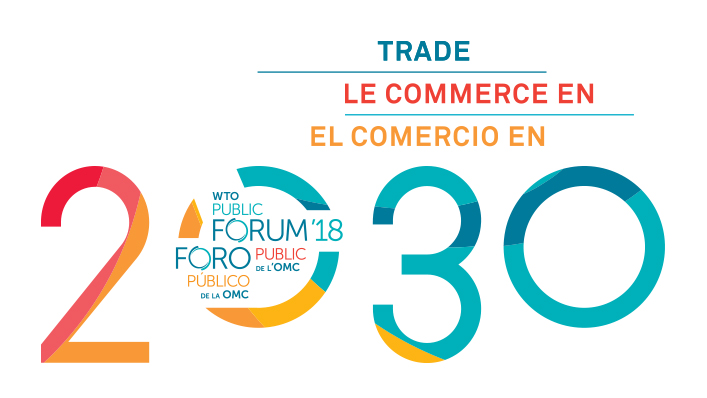Will technology help developing countries have easier access to trade finance
3 Oct 2018 02:00h
Event report
The workshop was organised by the Permanent Mission of the Islamic Republic of Afghanistan to the WTO, and the Economic Research and Statistics Division of the WTO. It addressed the post-2009 financial crisis that left developing countries with persistent and large trade finance gaps, and aimed to discuss the eventuality of new technologies such as e-payments, blockchain, fintech, and helping bridging the gaps.
Moderated by Mr Marc Auboin (Counsellor, Economic Research, WTO and Secretary, WTO Working Group on Trade, Debt and Finance), the session was introduced by Mr Mohammad Q. Haqjo (Ambassador and Permanent Representative of the I.R. Of Afghanistan to the WTO, Chairman of the WTO Working Group on Trade, Debt and Finance). He structured his speech around two key areas: the reasons behind the discussions on trade and finance in the WTO; and the role and mandate of the Working Group on Trade, Finance and Debt. First, he explained the reasons behind the trade, finance and debt discussions at the WTO. There is a deep interlink between trade and finance; 8% of today’s global trade has been financed through financial institutions. At present, everything is divided and institutionalised to facilitate trade, including for those struggling in accessing finance. Second, he talked about the Working Group on Trade, Finance and Debt which was established at the ministerial meeting in Doha, with the aim of studying how trade can best contribute to solving the problems of debt and finance. The group is currently focusing on ways to address the financial gap in developing countries, due to the following problematic variables: 60% of rejections in accessing finance are to small and medium sized enterprises (SMEs), moreover, banks have decreased their presence worldwide, creating a financial service gap, while regulations have become stricter, decreasing bank-to-bank transactions and relations. As a result, less money has been exchanged. The market is only for local banks, however, local banks in developing countries are lacking in human and institutional capacity. With this regard, he explained how a dialogue platform with private banks has helped in providingé loans for developing countries, and to the efforts put in place by the WTO in training professionals in 85 countries worldwide. Finally, he stated that the knowledge gap and digital divide are still the main obstacles in front of the implementation of technology for trade finance.
The second panellist, Mr Jean-François Lambert (Chief Executive Officer, LambertCommodities Inc.), talked about challenges small businesses in developing countries face. He shared his concerns regarding the capacity gap of local banks in providing access to finance. He argued that the trade gap persists as well, since currently the main lending activities are made to the same big companies, stating that ‘banks have forgotten big parts of the world’. Moreover, he continued by saying that large banks do not want to take the risks and responsibilities that come with supporting local banks, and that political instability present in certain developing countries could also be a factor. Concluding his speech, he expressed his view saying that the current obstacles and challenges are not only represented in the financial gap, but also by a cultural gap.
The third panellist Ms Michelle Chivunga Nsanzumuco (Regional Advisor, British Blockchain Association; Executive Education Manager, University of Surrey Business School), addressed the topic of bridging the financial gap with new technologies, especially blockchain. The opportunities that blockchain creates are strictly related to the concept of creating value. She argued that blockchain is an enabling technology for everyone: it allows people to create their own value, such as M-Pesa did in Kenya; opening the market to local people; providing identity to people, and SMEs with digital identities, allowing them access to the market. Finally, she stated that despite the fact that blockchain is in its initial stages, there are significant uses already in place, and the way business is done will be increasingly affected by such technology.
The fourth panellist, Mr Vinay Mandonca (Global Head of Products, HSBC Trade and Receivable Finance), expressed the need for a paradigm shift in the way credit is assessed. The digitalisation of transactions through blockchain has positive effects on credits assessment, as ‘visibility is a proven point’. He argued that it comes down to the concept of transparency of flows. Consequently, a question could be raised: Who is going to share the information, and with whom? In this context, blockchain represents a good opportunity because it does not require a database, and utilises decentralisation and democratisation for all processes. It creates the possibility of having a network of networks. Singapore’s new National Trade Platform is already using blockchain and benefiting from it.
The final panellist, Ms Emmanuelle Ganne (Counsellor, Economic Research, WTO), briefly commented on the points raised during the discussion. She argued that blockchain can be extremely helpful in building trust between actors, and providing more accurate traceability. However, traditional trade finance has not yet completely moved to the application of such technologies. With this regard, Ganne stressed two main points. First, blockchain technology guarantees the information that has been uploaded, but it does not guarantee the authenticity of such information. Second, is the question of interoperability; there are various blockchain technologies that are not interoperable with each other. Blockchain works best when the information is shaped through the same model.
After this overview of blockchain technology, she addressed the topic of new technologies enabling traders to move to a peer-to-peer model, without engaging with a bank. She argued that there are already fintech that leverage technology, and help SMEs to build their trade history; however, despite the new opportunities that technology creates, we are still trying them with the aim of benefitting from the intrinsic characteristics of such technologies.
Related topics
Related event

